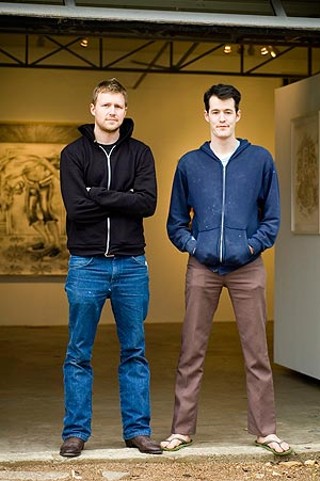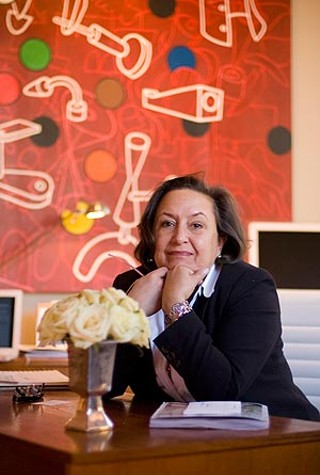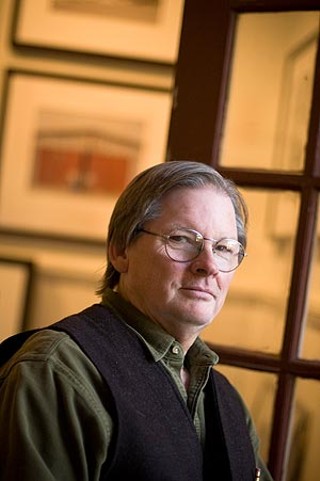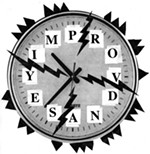Show and Sell
Austin art is getting national buzz, but is anybody buying it?
By Clayton Maxwell, Fri., March 14, 2008

Austin is a city proud of its talents and wares, and we try to buy accordingly. There are many among us who take a kind of twisted pride in spending our last dollar on concert tickets or music by local musicians. Food from local farms, coffee from local coffeehouses, clothes from local designers – the prevailing attitude is that it's all cooler, tastes better, and is good for the local economy, not to mention the culture. Shouldn't the same go for art? Is it too much to ask to enter someone's house – or new condo Downtown – and want to see local artists or galleries represented on the walls?
After all, the energy generated by Austin galleries and artists over the last few years has grown from cool hum to high-frequency buzz. The East Austin Studio Tour, started by three young artists six years ago, has become one of the most popular art events in town. It was a group of Austinites (from Bolm Studios, Camp Fig, Gallery Lombardi, Eastside Coop, and the Dougherty Arts Center) that launched the Texas Biennial, a multiple-gallery show of emerging Lone Star contemporary artists. Okay Mountain, a nine-member art co-op, has managed to pool resources and bring in artists from Tokyo and Egypt, run a store, and publish first-rate books of their members' tag-team drawings. Austin Art Alliance's Art Talk Austin, a series of discussions by artists, collectors, and curators, has helped people learn more about art-collecting. The visual-arts scene has seen better-attended openings; friendlier relations among artists, galleries, and museums; and a larger and more involved public.
Even the national media has noticed. A December 2007 article in Art in America, "Report From Austin: Art by Southwest," suggested that the visual arts might no longer be this city's neglected child, outshined by our longstanding love for music and film. Earlier in the year, readers of AmericanStyle Magazine voted Austin eighth best art destination in the U.S. For a 2006 article on Texas style, New York Times fashion writer Cathy Horyn visited Austin gallery Art Palace and became smitten, writing that she "felt an exhilaration seeing the work" and that "it was exactly what I'd hoped to find." Since its reopening two years ago, the Blanton has boosted Austin's presence on the international art radar, as has the hard work of Dana Friis-Hansen, the much-praised director of the Austin Museum of Art since 2002. Austin art is on the rise.

Nonetheless, when I tell an art collector friend that I'm writing an article on the Austin art market, he replies, "It must be a very short article." This sentiment – that the art market here still lags behind the quality of the art being made – is prevalent. In talking with gallerists, the words "untapped potential" were used more than once to describe art sales here. And only one of those gallerists and not a single artist I spoke with for this story felt that things have improved remarkably in the art market here over the past three years, despite the buzz. More people are open to more types of art, but the new joy is not reflected in sales. Not yet.
Not that nothing is selling. You only have to spend time within the white walls of Art Palace to see that some collectors are snatching up local art. By the time Eric Zimmerman's show opened at Art Palace on March 1, almost two-thirds of his graphite drawings were already sold. Jonathan Marshall's December show, "The Book of Lenny," made at least $38,000 – pretty remarkable for a 24-year-old artist and a 2-year-old gallery. Even better is the fact that one of Marshall's pieces was bought by a private collector and then acquired by the Blanton, and AMOA bought another two: an unprecedented success for a young Austin artist. Another piece, still unsold at the time of our interview, was a 7-foot-bear, but the Palace's Arturo Palacios was confident: "I will sell that bear."
Gallery Shoal Creek, Wally Workman Gallery, and Stephen L. Clark Gallery, all of which have been selling art in Austin for more than two decades, are also seeing good sales – not a boom but steady growth. Workman, for example, set a goal to improve her 2007 sales by 25%, and she did. Still, she doesn't think that the new energy in the Austin art scene and attention in the media are necessarily changing the way that Austinites buy and sell art. "I thought it was quite interesting that some artists from L.A. called to tell me they hear Austin is a good place to sell art." In Workman's case, it seems that improved sales have more to do with her hard work and persistence than with Austin's increased visual-arts brio.
Still, many in the local art scene are optimistic about the growth of the art market. One is Meredith Powell, director of Art Alliance Austin, formerly the Austin Fine Arts Alliance. It has been supporting the arts locally for five decades, beginning with the Fiesta arts festival at Laguna Gloria, which has moved Downtown and was recently renamed Art City Austin. Powell said that sales at the 2006 event were underwhelming, but 2007 was a record year: "The artists were very happy with results." When we spoke, Powell was particularly enthusiastic; in the first days of the recently opened exhibition for the organization's new office and gallery Downtown, they had sold several pieces, mostly to young people, some even to walk-ins off the street.

But it's still ebb and flow, and while there are signs of growth, it's still too early to get cocky and throw a party. Any line graph of art sales here would look like a landscape of the Hill Country. For example, Okay Mountain is one project that you'd think would be pulling in the sales. Their work is strong, fresh, affordable. They work hard and are the creative darlings of the Eastside, the ones that everyone loves to love. And yet, according to their talk at the Creative Research Laboratory in late January, not a single piece from their latest show, "Gold Rush," had sold to anyone in Austin. They had seen a notable increase in international sales via their website, just no sales to the locals. Sales were never their motivation, but at CRL, the group made it clear: They don't earn a dime with Okay Mountain.
Workman, who works almost exclusively with local artists and has a largely Texan collector base, believes that sales tend to fluctuate with the local economy. In the glory days of the late Nineties, art sales in Austin were booming, she says. But after 9/11, people stopped buying, just like in the rest of the country. So, despite the Austin arts' growing reputation, she hasn't noticed any really remarkable changes or trends in the past few years, just the same ebb and flow she has seen throughout her 25 years as a gallerist.
Inconsistent sales are to be expected, however, in a city that is still young, as Austin is in many regards. It only began to outgrow its identity as a strictly university-and-government town 30-odd years ago. Compared to Houston and Dallas, there is a short history of art collecting here. Peat Duggins, artist and Okay Mountaineer, characterizes it this way: "The recent energy/attention given to the emerging art scene is great, but we need to retain the stress on 'emerging.' A developed art scene has insightful writing, numerous types of galleries, respectable institutions, and strong individual creators, as well as a collector base. The city has had some of those things at different times in the past, though I think we are just now starting to develop them all in tandem."
While few gallerists had their sales broken down into buyer demographics, several said younger people are now buying, a good sign that this art scene will keep growing. The day before I stopped by Stephen Clark's West Sixth Street gallery, two women in their early 20s, both former photography students at St. Stephen's Episcopal School, came to the gallery to buy name photographers. Clark says: "Art collecting is now happening at different levels. I've seen many people in this town as they make that first step, buying what they can afford. My generation was a poster generation, but now I see the children of my generation, children who went to good colleges, have traveled, and have been exposed to art in ways that earlier generations in Austin were not. They know what they like and want to buy name photographers. This didn't use to happen."
This mindset is explained by Salvador Sosa, a 42-year-old art collector I met at a recent gallery opening. He and his partner, Chric McKoy, invest in local artists and would like to see their peers do the same. "About six years ago, I looked at what was happening in Austin, and it really drew me in," Sosa explains. "I had been buying from galleries in New York and Santa Fe, but what I started to see in Austin felt more like what you'd see in New York. I used to buy when I traveled, but now I buy in Austin." Furthermore, Sosa sees how art collecting can be contagious: Some of his friends have admired the art in his home and now are buying original works of their own. Besides, as Sosa told a reluctant-to-buy relative, "If you are a grownup, you can't have fucking posters on your wall." McKoy, 48, an art teacher at St. Andrew's Episcopal School, put it this way: "The art happening in Austin is fresh, young. And it's a mirror of who we are right now, a reflection of our culture. It's not like going to Dallas and buying something that matches your couch."
And because the market here is still emerging, it's also still very affordable; there is great work here that's accessible to a wider swath of the population. This helps attract the younger collectors. "The buyers here have been mostly people in their early 30s excited about the work," says Powell. "They are buying what they love, and they can because it's affordable."
Of course, money isn't everything. It doesn't seem to be even a significant factor to many – they consider other positive factors much more important. Judy Taylor, who opened Gallery Shoal Creek in 1965, says more Austin collectors are now open to a wider range of contemporary art, far beyond the landscapes and still lifes that once dominated local art sales. Lora Reynolds has found a welcoming audience here for the cutting-edge international work she has brought to town since opening her gallery three years ago – and her fun, well-attended gallery openings prove it. Many gallerists see a fresh energy here. As Anastasia Colombo, the associate director at D Berman Gallery says, "I am incredibly optimistic about the Austin art scene. People are really sitting up and taking interest in being more supportive."
And yet, there is a big difference between "taking interest in being more supportive" and actually buying art. Many strong artists and galleries still have to scrap and juggle to survive, as Colombo sees in her position as treasurer for Art Austin, a 24-member gallery alliance. "There are galleries in town that are not a part of Art Austin [any longer], not because they didn't want to be but because they couldn't pay the dues, which are very moderate. Galleries still close because they are losing too much money. It is a fact that in Austin it's crushingly difficult to keep a visual-art space open. You can go look at the art, think it's beautiful, but if the artists don't get paid, they can't afford to be artists. I would like to see more artists be able to support themselves with their art instead of taking second jobs."
Sterling Allen, an Okay Mountaineer who has had successful independent shows as well, has a similarly sobering view: "I can count on two hands the people that are out there supporting our contemporary art scene," he says. "They are also the people who support the nonprofits and museums by funding special projects and exhibitions. I don't have any friends who can consistently work on art. Everyone I know goes through cycles of work/art if they are lucky. ... Everyone at Okay Mountain works almost full time on other stuff besides art."
As Stephen Clark put it, "The only way to really support an artist is to write a check." He and several other gallerists said that one of the best parts of owning a gallery is exactly that: paying the artist when works sell. And they all would like to see it happen more, not just for the gallery's sake but because they genuinely love the work they sell and want to see their artists thrive.
If more people buy Austin artists' work, the quality of art will improve. Not to reduce art-making to monetary terms, but an artist getting paid for his work translates to more studio time and other resources for making better art. No artist I contacted would stop making art for lack of sales – no one is an artist for the money – but having someone buy work can be the ultimate compliment and motivator to keep on working. And as your career gets more serious, it helps you pay for supplies, studio space, rent, life. As Sterling Allen explains: "[Getting paid] didn't used to matter. I liked showing, and it was a bonus to sell. In the past few years, it has become more important. I respect my own work that much more, and it simply isn't enough to have someone like it. I want to be rewarded for it. I also would like to get to the point where I wouldn't have to go to work and sit at a computer all day and instead just focus on art. I will always make stuff no matter what, but it is very encouraging to sell work. It keeps you going. As we get more mature and ambitious in our practice, the cost of making work also goes up. I didn't used to need a studio. I also didn't used to worry about safely shipping work. The more serious and dedicated you become, the more expensive life gets."
Emily Hoyt, abstract oil painter at the Pump Project Art Complex, agrees but also believes the positive effects from increased sales will stretch beyond individual artists to the entire scene. "I don't think money could ever improve my attitude about creating. It's something I have done out of necessity for some time," she says. "Although the fact remains that money won't change my reasons for making art, it's still obvious to me that if I sold a larger piece, I would jump at the chance to quit my day job and focus on art for as long as the money kept me going. In this very significant way, the art market in Austin can benefit from artists getting paid real money for their work. More artists selling means more time and thought going into the innovation of work. For artists who have been struggling to remain active, this boost could mean significant gains in the quality of art-making in Austin."
For a city that thrives on its individuality and seeks to stay weird, more sales of local art doesn't seem too much to ask. As Powell says, "Austin is known as a creative city, but how do you expect to sustain a creative culture if you aren't supporting the ones who make art?"










